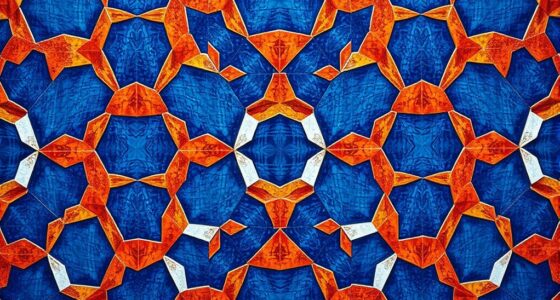Transformations 101 covers the basics of moving shapes without changing their size or shape. Translations slide a figure across the plane, rotations turn it around a fixed point, and reflections flip it across a line. Each preserves the shape‘s size and symmetry, helping you recognize patterns and properties. Understanding these transformations allows you to see how figures behave and interact in different ways. Keep exploring to discover how these concepts work together in more complex situations.
Key Takeaways
- Translations move shapes without changing their size, shape, or orientation by adding values to coordinates.
- Rotations turn shapes around a fixed point, maintaining size and shape but changing orientation.
- Reflections flip shapes across a line, creating mirror images while preserving size and shape.
- Visualizing transformations helps understand how symmetry properties are preserved during movement, rotation, or flipping.
- Common transformation angles include 90°, 180°, and 270°, which reveal different symmetry characteristics.

Have you ever wondered how simple changes can lead to remarkable results? When you explore transformations, especially in the context of the coordinate plane, you discover how shifting, turning, or flipping a shape can produce impressive effects. These basic movements—translations, rotations, and reflections—are foundational in understanding symmetry properties and how figures behave within the coordinate plane. By mastering these, you’ll see that many complex patterns and structures become much more approachable.
Starting with translations, think of them as slides that move a shape from one position to another without changing its size, shape, or orientation. On the coordinate plane, you can visualize a translation as adding a certain value to the x- and y-coordinates of every point in the shape. For example, shifting a triangle 3 units right and 2 units up moves it to a new location while maintaining its original shape and size. This movement demonstrates how the shape’s symmetry properties are preserved during a translation. Recognizing these properties helps you understand that the figure’s fundamental characteristics remain unchanged, even though its position has shifted. Full attention to the details of each transformation enhances your ability to visualize and predict the outcome of these movements.
Translations move shapes without changing their size or orientation, simply shifting their position on the coordinate plane.
Rotations involve turning a shape around a fixed point, often called the center of rotation. When you rotate a figure, you’re essentially spinning it around a point on the coordinate plane by a certain angle, such as 90°, 180°, or 270°. During this process, the shape’s size and shape stay intact, but its orientation changes. Visualizing this on the coordinate plane helps you see how the shape’s symmetry properties come into play—some figures are symmetric under certain rotations, meaning they look the same after turning. Recognizing these rotational symmetries allows you to predict how figures will behave under rotations, which is especially useful in design and problem-solving.
Reflections are like looking into a mirror; they flip a shape across a line, creating a mirror image. In the coordinate plane, you can reflect a shape across the x-axis, y-axis, or any other line, and it will produce a new figure with symmetry properties related to the line of reflection. For instance, reflecting a shape across the y-axis mirrors its position horizontally but keeps its size and shape intact. Understanding symmetry properties during reflections helps you see how shapes can be manipulated while maintaining their core structure. This notion is vital when analyzing patterns, tessellations, or designing symmetrical objects.
Frequently Asked Questions
How Do Transformations Differ in 3D Space?
In 3D space, transformations differ because they involve a three-dimensional coordinate system. You’ll use transformation matrices to manipulate objects, applying scaling, translation, rotation, or reflection across different axes. Unlike 2D, you deal with additional axes (z-axis), making your matrices larger and more complex. This allows precise control over object positioning and orientation, giving you the ability to perform complex spatial transformations seamlessly in 3D environments.
What Are the Real-World Applications of These Transformations?
You use transformations like translations, rotations, and reflections daily in animation effects, bringing characters to life and creating immersive scenes. In architectural design, these transformations help visualize structures from different angles, ensuring accuracy and aesthetic appeal. They also streamline modeling processes, making complex designs manageable. Whether in digital animations or building layouts, understanding these transformations enables you to manipulate objects effortlessly, improving creativity and precision across various real-world applications.
Can Transformations Be Combined for Complex Shapes?
Yes, you can combine transformations for complex shapes through composite transformations. By applying a sequence of transformation steps, or transformation sequences, you can create more intricate and precise shapes. For example, you might translate, then rotate, and finally reflect a shape. This approach allows you to manipulate objects in various ways, making it easier to design complex figures in art, engineering, or computer graphics.
How Do Reflections Differ From Flips Across Axes?
Reflections differ from flips across axes in that a reflection creates a mirror image across a line, known as line of reflection, maintaining reflection symmetry. An axis flip specifically refers to flipping an object over a particular axis, like the x- or y-axis. Fundamentally, both involve flipping, but “reflection” emphasizes the mirror symmetry, while “axis flip” highlights the specific line of transformation. Both are types of transformations that change an object’s orientation.
Are There Software Tools to Visualize These Transformations?
Yes, you can find many graphical software and visualization tools to explore transformations. Programs like GeoGebra, Desmos, and Geometer’s Sketchpad let you easily visualize translations, rotations, and reflections. You simply input your shapes or points, and the software shows how they move across axes or rotate. These tools are user-friendly and perfect for understanding the effects of different transformations interactively.
Conclusion
Now that you’ve explored the basics of translations, rotations, and reflections, you’re better equipped to see how shapes dance across the plane. These transformations gently reshape your understanding of geometry, revealing its subtle elegance. With each move, you’re not just manipulating figures—you’re uncovering a world where change is both natural and beautiful. Embrace these concepts, and you’ll find that even the simplest shifts can lead to surprisingly profound insights.








